
LED lighting has gradually come to the fore over the past five years. This LED illuminated display created by Leach Impact demonstrates how LED-lit signage can be used to grab attention
The rise of the LED over the past five years or so has been nothing short of astronomic and their place in the sign industry has been firmly secured.
As LED technology has developed, lighting systems and signage applications have become ever more sophisticated and innovative, with new and improved products regularly making their entrance on the scene. So, I thought it was time to have a quick round-up of some of the latest technology and systems currently on the market.
Life just got easier
Not only do LEDs provide massive improvements in sign illumination, installation and maintenance have also become easier.
Ivan Lew, director at Spectron LED, recalls: “There was a time when a trough light was the size of a tree trunk and the weight to go with it. For years sign installers were faced with the difficult situation of finding the best possible way to install the trough light. But with the advent of LED technology, the size of the trough light has reduced greatly; no longer do you need to change fluorescent tubes or starters—we can all remember what a nightmare that could be; and then there was the matter of how much you could bill your customers to justify it.

Spectron LED’s Lumenlinear-X trough light system is designed and manufactured for easy installation and maintenance
“With that in mind, in the unlikely event of the LED failing, Spectron’s Lumenlinear-X trough light is one of the easiest systems when it comes to repair and maintenance,” says Lew, adding: “Individual LED light modules can be replaced in situ, and up to 15m of trough light can be powered by a single waterproof driver which can be replaced externally with ease.”
Designed and manufactured by Spectron, the Lumenlinear-X trough light offers low energy cost and long life, and features a sleek and stylish looking profile. In addition, for further ease of installation, the new V3 fixing bracket from Spectron has been designed as a ‘one for all’ system.
“No longer will you turn up on site and find that the bracket supplied is not suitable, no longer will you need to pay for a double-sided sign bracket that could cost more than the light itself. The V3 bracket is suitable for wall fixing, ledge fixing, you can even fit it in between the recesses of cladding, all with variable projection. There is nothing quite like it on the market,” concludes Lew.
Chain letters
Hansen UK, a division of Sign-Tec Services, has been enjoying success with its LEDchain product, with several UK sign letter manufacturers adopting it for major projects.
LEDchain was designed to illuminate solid acrylic letters. The LEDs are embedded in grooves milled into the rear of the letters, which enables the production of very small and flat letter signs with a very bright and uniform illumination. In addition, LED spacing, to suit the depth of the letters, LED power rating and hence brightness, light colours, and colour temperature for white LEDs can all be varied.
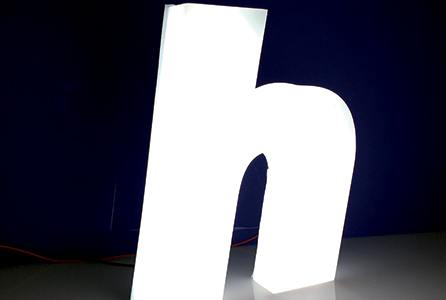
Hansen UK’s LEDchain was designed to illuminate solid acrylic letters and the company has been enjoying success with the product
Comprising LED, protective diode (Zener diode), and power converter, Hansen LEDchain can also be used to illuminate letters facing forward or for halo effects.
Each LED and protective diode is fitted to a small circuit board, and the individual circuit boards are connected by wires of the same length soldered to make a chain. The components and connecting wires are not enclosed and the chain can be split or reconnected after each LED. Electrically, the LEDs form a series connection, and the connecting wires between the LEDs can be bent, allowing the LEDchain to be routed around tight radii, corners, and curves.
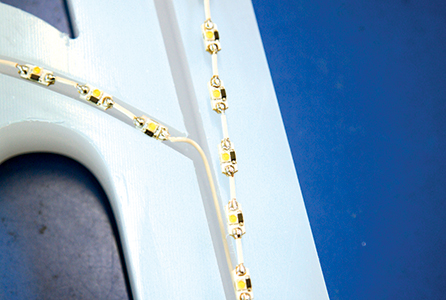
With LEDchain from Hansen UK, the LEDs are embedded in grooves milled into the rear of the letters, which allows the production of very small and flat letter signs with a very bright illumination
Special Hansen power converters operate the LEDchain, supplying a constant current protecting the LEDs against overloading.
“This method of operation also removes the problems of voltage-dropping along cables feeding the sign, which means that the power converters can be placed many metres away from the sign if desired,” comments Graeme Browse, director of Hansen UK and Sign-Tec Services, adding: “As an extra bonus, this method of powering the LEDs can save up to 17.5% of the energy required by comparable 12V parallel wired LED installations.”
The LEDchain can also be embedded in optically clear resin to produce sealed letters for outdoor use.
Hansen manufactures a wide range of products—LED, neon, and control devices that cover all areas within signage and advertising lighting—all produced in Germany utilising the newest technologies in lighting.
Browse explains: “The products are by nature very flexible in use and installation. Hansen can also offer custom adapted and specially designed products for installations that are not straight forward.
“Sharing our knowledge and expertise and co-operating with our customers can ultimately offer solutions which can save a lot of time and money on lighting projects, through development, production and installation,” adds Browse.

Sharing our knowledge and expertise and co-operating with our customers can ultimately offer solutions which can save a lot of time and money on lighting projects”
Other LED lighting products offered by Hansen include LEDtube, which comes in four compact options for use in all sizes of application, from small letters to fluorescent tube replacement; and Edgelight, custom sized luminous panels that reduce installation time required and minimise materials required for sign production as signs can be made down to 2cm depth with completely uniform illumination.
“This extremely energy efficient and cost effective solution is already in use in restaurants, shops, airports, and so on both indoors and outdoors, across Northern Europe,” says Browse.
Guiding light
Designed, developed, and manufactured in-house, Zeta Specialist Lighting’s new Light Guide Panel (LGP) is a flexible, energy-efficient solution to deliver optimum illumination across a variety of applications including wayfinding, advertising poster cases, totems, monoliths, and even road signs.
“Each Light Guide Panel is made from the highest quality UK acrylic, and the unique grid pattern etched into the acrylic ensures shadow free illumination and delivers uniform light distribution, ensuring optimum performance,” notes Zeta Specialist Lighting’s managing director, Adrian Dennis.
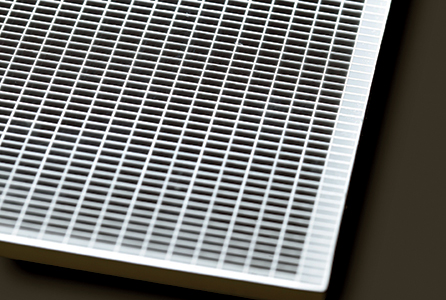
The unique grid pattern etched into the acrylic of Zeta Specialist Lighting’s new Light Guide Panel (LGP) ensures shadow free illumination and delivers uniform light distribution
Featuring an ultra-slim profile starting from just 6mm (thickness up to 15mm is also available on request), the Zeta LGP is available in bespoke sizes and shapes, and can illuminate a surface area up to 2.4 x 2m.
Dennis continues: “This cost-effective, space saving, easy to install solution can be used in both single and double-sided applications and has a waterproof option available, making it suitable for both outdoor and indoor use. Zeta’s ultra-efficient LEDs with an average rated life of 50,000 hours are available in a range of colour temperatures along with RGB options, providing scope for sign-makers to offer a range of different effects and mood lighting.”
In addition, when combined with the Zeta Solar Kit, sign-makers can offer clients solar-powered signage illumination, making it ideal for use in areas where there is no easy access to mains power and where laying cabling is cost-prohibitive, a system that further reduces installation and running costs.
Also new from Zeta is the SmartScape Solar Bollard wayfinding solution—the first solar-powered LED system in Zeta’s Smart Scape range of street and area lighting products.
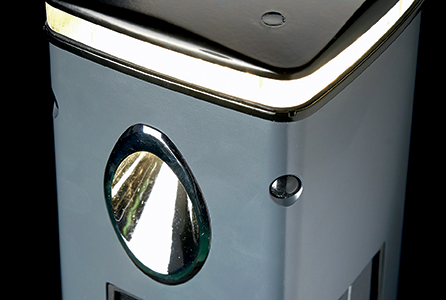
Zeta Specialist Lighting’s SmartScape Solar Bollard wayfinding solution is the first solar-powered LED system in the company’s SmartScape range of street and lighting products
Available in extruded aluminium or sustainably sourced wood finishes, it contains two LED lights, one of which runs at a low lighting level continuously, ensuring it can be seen from a distance, while the second downlight reflector lamp incorporates integrated PIR sensors that automatically increase the lighting level when there is activity in the area, saving energy and reducing light pollution.
The Smart Scape Solar Bollard is specifically designed to capture and store solar power via its integrated PV panels and as it requires no on-grid connection, it is ideal for use in areas where there is no mains-fed power supply.
Sheet lighting
Lighting technology is constantly improving and evolving and from this, new and cutting-edge lighting systems are produced. Such advancements in LED lighting have been employed by Applelec to create the individually addressable LED Light Sheet and tuneable white LED Light Sheet, which reflect the latest developments in colour-changing and temperature adjusting LED innovations.
Progressing from RGB LEDs is Applelec’s individually addressable LED Light Sheet. Differing from RGB, whereby all LEDs are set to the same colour and then change as one unit, individually addressable LEDs provide the facility to programme each LED independently, enabling impressive illumination patterns to be created.
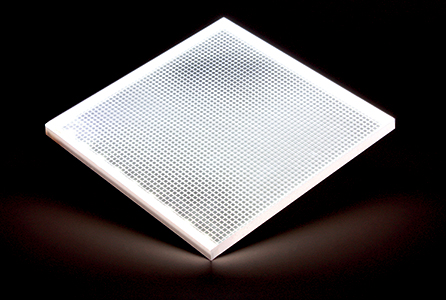
Advancements in LED lighting have been employed by Applelec to create the individually addressable LED Light Sheet and tuneable white LED Light sheet
“This technology widens the possibilities of what can be achieved with colour-changing LED illumination and a number of sophisticated effects can be created, such as colour merging and sweeping sequences,” remarks Andy Armitage, head of signage sales at Applelec.
LEDs are available in a scope of colour temperatures ranging from cool (blueish) white at 6500K, to warm (yellow looking) white at 2700K, however only one colour temperature can be used per application. A lighting system which eradicates this issue is Applelec’s tuneable white LED Light Sheet. This LED system offers flexibility by enabling a combination of temperatures to be used within the same unit, allowing the freedom to adjust the colour temperature as and when required.
The temperatures on the tuneable white LED Light Sheet can be modified by hand as necessary using a DMX touch controller, which can also be paired to wireless devices for added convenience.
“These pioneering LED light systems are embedded into Applelec’s LED Light Sheet in depths of as little as 8-10mm and are suitable for use in signage systems,” Armitage observes.
Fast forward
Looking to the (not so distant) future, Milap Ladwa, display expert at Leach Impact, gives an overview of what we can expect to see in the coming year.
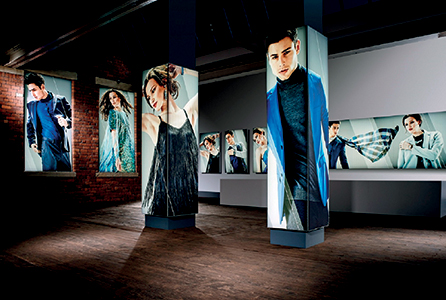
Milap Ladwa, display expert at Leach Impact, says that brands can be more creative in how they communicate with people in high traffic areas, such as columns and 3D structures
Ladwa believes that programmable dynamic LED lighting systems will change the face of signage in 2017. “LED lighting has gradually come to the fore over the past five years, replacing outdated fluorescent tubes with energy-efficient, consistently rich LUX levels. And as systems have evolved so too have brands’ desire to be bold,” says Ladwa.
He continues: “LED-lit signage is no longer something reserved solely for the outside of buildings. It is increasingly being used to grab attention and deliver the ‘wow factor’ throughout a variety of internal spaces, from exhibition halls and retail stores, to commercial buildings and receptions. Yes signs can still ensure people get from A to B, but brands—with the help of display system specialists—can be more creative in how they communicate with people in high traffic areas.”
So, 2017 will therefore be the year that organisations use dynamic LED lighting systems to create the perception of movement. Ladwa elaborates: “Lightboxes don’t just have to be static. They can be programmed to produce a strobe effect, for example, or give the illusion of snow falling or fireworks exploding. Brands will no longer have to invest in expensive video walls to create such compelling visuals.”
O Factoid: The first light-emitting diodes (LEDs) were very expensive, costing some $200 (around £154) per piece. As a result, they were used as indicators only in highly professional laboratory equipment. O
Aside from the most conventional wall-mounted signage, these dynamic solutions are available in columns, 3D structures, and even systems integrated into product displays.
“It’s amazing to see clients being bolder with their utilisation of signs, meaning they’re sometimes less about information and more about impact,” Ladwa concludes.
So, the inexorable march of the LEDs continues to invade our signage. They have clearly moved way beyond their initial benefits of brightness, energy efficiency, and environmental friendliness and increasingly offer the means to creating innovative and dynamic applications that can be embraced by sign-makers in order to provide their customers with eye-catching creative signage solutions.
Your text here...